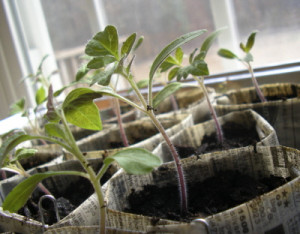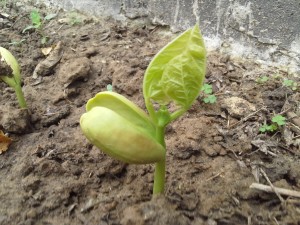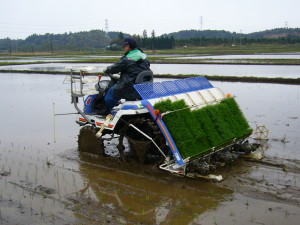Thigmomorphogenesis...Say What?

What Exactly is Thigmomorphogenesis?
I've always been one of those educators that hates big "sciencey" words that scare students and visitors when they come to my programs. Long words with complex Latin roots can lose attention and seem overwhelming to the average reader too. However, as a philosophy major and scientist I have a deep love of the break-down of words and their etymology. Today's word is just too good to pass up. It's an important ecological concept critical to those who own gardens and grow plants.
Thigmomorphogenesis is pronounced th-ig-moe-morph-O-gen-eh-sis. In Greek thigmo means "touch," morpho means "form" or "shape," and genesis means "origin" or "coming into being." Essentially, thigmomorphogenesis means "a shape coming into being from touch." How cool is that?
This term is most often used in botany and agriculture. It refers to growth patterns of plants. Plants need touch to grow strong and be robust. You wouldn't think of plants as being all "touchy-feely" but in their own ways they are. Thigmomorphogenesis refers to the growth of plants that is influenced by the touch of wind, rain, or external stimuli. If you've ever tried to grow plants indoors or in a greenhouse, you know that the seedlings often appear weak or spindly. You have to "harden" or acclimate them outside for increasing periods of time before putting them into the ground. This is because plants need the touch of wind, rain, or animals to encourage cellular thickening of their stems and shortening of their bodies (slowing upward growth).

You can see examples of this every day when you walk outside. Look at hedgerows where wind blows consistently. The plants will be shorter and thicker than hedges that are not exposed to wind. The same is true for footpaths where animals pass regularly. You'll see that the plants lining the path are shorter and thicker than their counterparts a distance away. Highways are good places to look for this. The trees closest to the road are shorter and have thicker trunks than those farther away from the road, because of their constant exposure to wind from passing vehicles.
So what's the big deal this this thigmo-stuff?
When a plant is exposed to touch or external stimulus it grows more short and stocky, it reduces its shoot length, increases its stem diameter, increases its root depth, and thickens the cells walls of its xylem (pronounced zy-lem) or internal stem tissue. What's up with this? Thigmomorphogenesis is an adaptation that allows for plants to compensate for stresses in their environments. A plant that has a thicker stem, is more tapered, and has deeper roots will be better prepared to respond to environmental stresses and stimulus than a plant that has grown long and spindly. It will be more likely to weather the winds and rain without breaking, damage, or uprooting.

It's thought that thigmomorphogenesis is just as important to a plant's growth as the plant's response to growing toward light, roots seeking water, or even its response to growing upward in response to gravity. If plants didn't do thigmomorphogenesis we'd have weak plants bending and breaking all over the place, our crops would fail, and they wouldn't be hardy enough for their environment. There are lots of great research papers on thigmomorphogenesis, because it's super important to people who grow crops. Here are a couple from The Oxford Journal and the National Institute of Health (on pumpkins and other common foods).
What does plant growth through thigmomorphogenesis mean for you and those who make a living with plants? Bottom line, you need to stimulate your plants. Just playing classical music or rock n' roll won't work. You need to touch your plants. Now there are lots of fun experiments that people have done about touching plants.....you know some poor unsuspecting interns were paid for this. Researchers would touch a plant with a brush, or blow wind on the plant, and then measure the plant's growth response. They would measure vertical and horizontal growth over different periods of time (one day, two days, several weeks). This would help them determine how often a plant would need to be stimulated to promote optimal stem thickening and hardiness, and whether the thickening of the cell walls of the plant were localized (just the stem or branches) or if it was across the whole plant.

Stimulating plants sounds simple enough on a small scale but it grows infinitely more complex when you think about large scale agriculture. If you have huge greenhouses full of rows of plants, how do you stimulate them adequately? If you blow wind over them then you risk rapid dehydration and drying. Opening up the greenhouses is not feasible in some climates. The term that is used to describe what growers do is called "mechanical conditioning." Although it sounds like a dream job to some of us, rubbing the stems of individual plants or shaking their pots isn't practical, so people have gotten creative. There are lots and lots of different techniques that have been tried. You can read about them in this paper from the Journal of HortScience (click link). They include passing typing paper over the seedlings, rubbing them with suspended aluminum poles, dragging a cloth over them, spraying the plants vigorously, using "mechanical fingers" made of different materials, dragging netting, or even brushing with brooms. For some plant growers, instead of "Time to make the donuts" it's, "Time to stimulate the plants!"
Regardless of whether you're a small scale gardener, or a large scale farmer, it's super important that you understand thigmomorphogenesis. It will help you understand the needs of your plants, and how to prepare them for transferring from greenhouses and homes into your garden. This topic is really much more complex. There are many other fun words you should know, like thigmonasty or thigmotropism, that relate to a plant's response to the direction of stimulus (thigmomorphogenesis is mostly independent of direction). But, those terms are for another post. If you'd like to learn more, check out this post from the "Plant Life" blog. If you're interested in how to property stimulate, acclimate, and harden plants then try the Burpee website. Remember, when you're planting tree saplings outside, don't use a stake that goes all the way up the sapling, only about 1/4 to 1/2 the way up, this will allow the seedling to move and receive stimulus so that it can develop with proper thigmomorphogenesis.

One Last Closing Thought
The educator in me loves the topic of thigmomorphogenesis, because I see parallels to humans and animals. We all need touch stimulus to grow and develop properly. We're no different than plants. Touch, exposure to external stimulus such as wind, weather, drought, and temperatures, makes us more hardy and better able to handle our environment. There is a term coined for a lack of external natural stimuli, it's called "Nature Deficit Disorder." This deficit is a real thing. I've seen it in children and I've seen the effect that the stimulus of nature can have on children who are deprived of nature, even those with autism or mental disorders. External stimulus is critical to human growth and development. You can read more in the books by Richard Louv. Start with his classic "Last Child in The Woods." He's also written about this disorder in adults too.
"Touchy-feely" is something of a term of derision in our culture, but it's incredibly important in the natural world and we need to remember that despite all our gadgets and things, we're no different than plants and we can all use a little thigmomorphogenesis!

